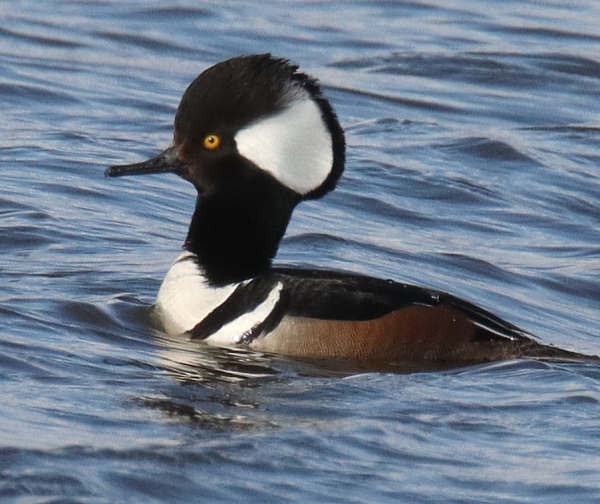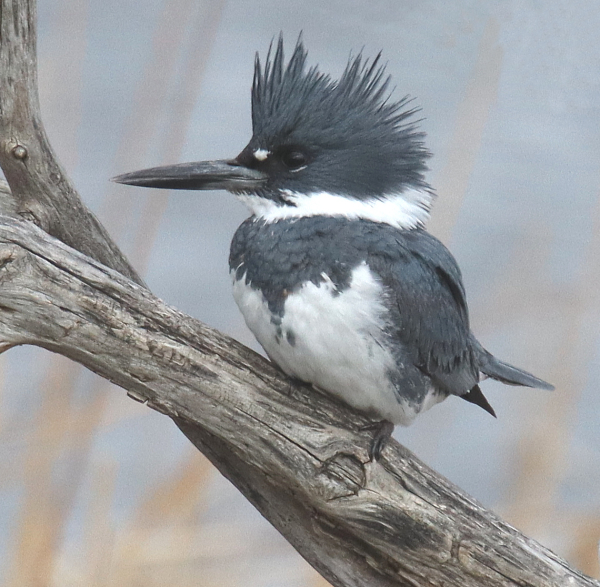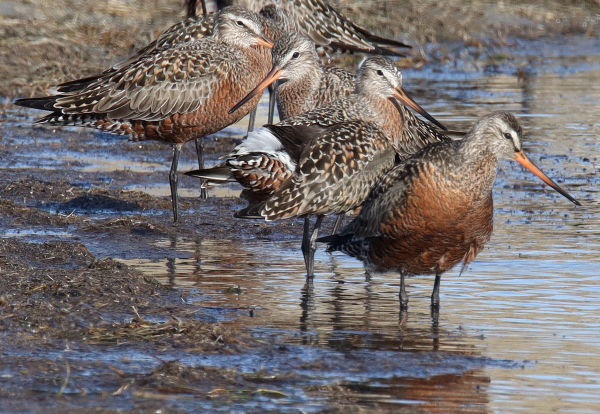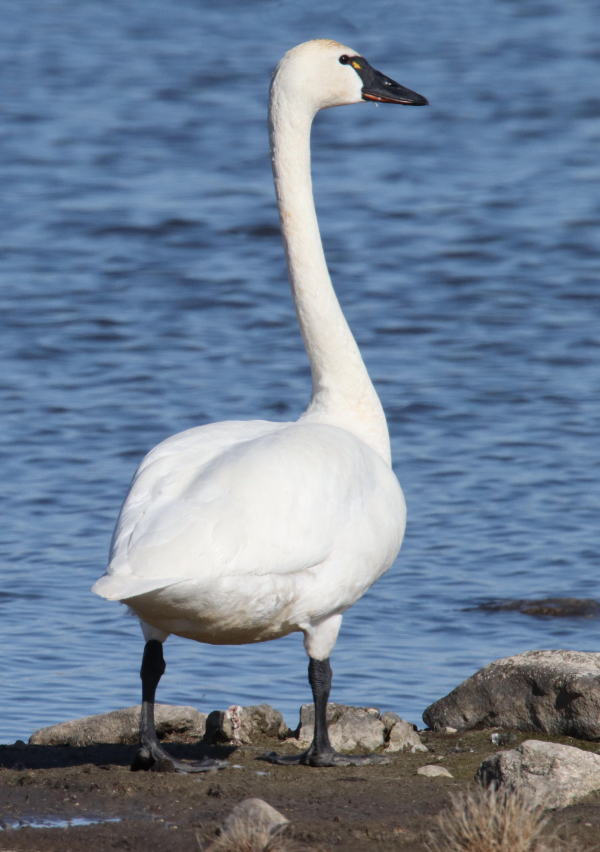
The surprise of finding a Red-necked Grebe was superseded by the opportunity to photograph it.

In the field, Hooded Mergansers can look like very different birds when their feathered “hood” is expanded, or when it is relaxed. This male was displaying toward a pair of “Hoodies.”

The first Belted Kingfisher of the year was a male that hunted from a number of perches.

Although many of the Bonaparte’s Gulls that migrated into the area last week had fully black heads, some were still molting into their full breeding plumage. Note the white leading edges of the primary wing feathers too.

Among the rarest of rare migration sightings, a flock of Hudsonian Godwits provided an interesting scenario to try to photograph them under somewhat unusual circumstances. You can read the story and see more photos in the Bird Photography feature in this issue.

Appreciating the size and majesty of Tundra Swans in close quarters is a special thrill, especially when it provides an unexpected chance to photograph them.
|
Never before have I seen such a beaming bright shining rainbow, offset against the dark sky; but it was the 160 closely swirling Turkey Vultures, seemingly held back from advancing their migration north along the James River by a thunderstorm cloud that provided the equally impressive rainbow and sky view. Upon seeing the double rainbow, my first thought was, “How can I align the energy of the gracefully soaring vultures together with the magnificent colors of the rainbow in the same camera frame?”
Knowing I was under a moment’s timeline, I drove east a few hundred yards to try to get into a position to align the birds with the beaming rainbow, but as it turned out I never saw the vultures again – not even one – and in a moment the rainbow disappeared too. Well, it will live on as a vivid memory as 2 birding views that never collided, except in my creative mind. The vultures were a big surprise, providing a little chase to keep up with them that ended with many of the birds sweeping the sky from 15 to 50 feet directly overhead like a swirling kaleidoscope – wooo!
These natural events topped off an exciting birding drive to Sand Lake National Wildlife Refuge, a favorite migration destination, spring and fall. But last Wednesday the newest and most abundant birds were clustered within a dozen miles of home – imagine that! Yes, during the past couple weeks, my home range has been a migration hotspot, with new birds arriving each day, and flocks of migrating birds stopping over in active groups focused on feeding and mating. Last week, the birds coupled with abundant sunshine provided a lot of incentive to get into the field, and stay there, searching out the next exciting flocks, individuals, and pairs, camera in hand, just in case – and what fun it was!
Daily sightings of new birds provided a base of excitement, and starting with last Tuesday’s news, I sighted the first of season Wood Ducks and a Belted Kingfisher. Wednesday an active flock of Bonaparte’s Gulls, a Lesser Yellowlegs, a Baird’s Sandpiper, the Turkey Vultures, plus a Mourning Dove that visited my bird bath were all first sightings of spring. Thursday it was a four-some of White Pelicans, a Sharp-shinned Hawk, a Yellow-headed Blackbird, and Pied-billed Grebe, plus a Fox Sparrow below my feeders; and Friday a pair of Wilson’s Snipe and the first nesting pair of Red-tailed Hawks were on hand at a nest that is traditionally the first to be activated. Saturday’s new additions were American Avocets and a Great Blue Heron, while the surprise new appearance Sunday was a Red-necked Grebe in the morning and a flock of 16 Hudsonian Godwits in the afternoon!
As new species arrive, it’s interesting to see how quickly their numbers increase and how flocks break down into territorial birds or pairs. Yellow-headed Blackbirds provided an excellent example of how after seeing the first lone male Thursday toward sunset, the following afternoon I crossed paths with a big flock of Yellow-heads – perhaps numbering 40 – all males. And by Saturday morning there were male Yellow-headed Blackbirds positioned territorially at cattail marshes scattered through the area, singing their welcoming song and adding to the marshland chorus. Gosh, it’s nice to have birds singing again!
A different example is the case of Lesser Scaup: These interesting ducks arrived in full force with many large flocks arriving within a couple days. Males appear to outnumber females, and the mating game is definitely defined by a few males “courting” a female, keeping company at times, and pursuing her more directly at other times. Mating and feeding bouts will continue until almost all scaup leave the area in flocks, headed for wetlands in Canada’s prairies and boreal forest region. Only a few pairs will stay in this area to nest, and that’s the case with most Canvasbacks, Redheads, and Ring-necked Ducks too.
Friday and Saturday were especially excellent days to be a birder, especially a birder with a camera! The blue sky, clear sunlight, and light wind teamed with a variety and abundance of birds in the area kept me excited to be afield. After a morning birding session I only returned home long enough to take a refreshing shower before taking another lap around the area to take advantage of the afternoon’s avian festivities.
A week after the true meltdown of area ponds, marshes, and lakes, ducks were present in abundance, with the largest flocks composed of Lesser Scaup and Canvasbacks, with occasional flocks of Redheads, Northern Shovelers, and Green-winged. Scattered Ring-necked Ducks, Mallards, Gadwalls, and Blue-winged Teal were common, with fewer Northern Pintails, Buffleheads, Hooded Mergansers, and Ruddy Ducks and even fewer Wood Ducks, America Wigeons, Common Mergansers, and Common Goldeneyes. That’s 17 species of ducks! And there were still some small groups of Cackling, White-fronted, and Snow Geese in the area – although they have departed, along with Tundra Swans.
Speaking of swans, I swung by Meier’s Lake Friday morning, which is a big fall stopover location for Tundra Swans about a dozen miles to the southwest. I was pleasantly surprised to see quite a large concentration of swans on the southwest side of that big lake, and counted 76 in all. But I lamented a bit that the swans were so far off in the distance, especially when I saw an occasional pair take flight, wishing for a photo opportunity with the big white birds. There were still 6 swans at Hill Marsh, but they were lying low, resting on the lee side of an island in the midst of the expansive wetland, so they didn’t help to satiate my photo interest.
Swan Excitement!
But that afternoon, as I eased over the hill at the northeast corner of Charo Marsh, my jaw must have dropped as I gasped air as I saw 4 statuesque Tundra Swans on the shore, just a 50 feet from the road in perfect sunlight. Before I could exhale, the multitude of ducks that surrounded the swans took flight en masse – Canvasbacks, Lesser Scaup, Green-winged Teal, Gadwalls, and Northern Shovelers – but the yellowlegs and swans remained. There had been a few swans on Charo Marsh since the ice began to melt, but they were always feeding or loafing far in the distance. Now, here they were, well within photo range!
Easing down the vacant dirt roadway, a couple more ducks flew up, but the swans permitted me to park with the sun at my back and the 4 big beautiful white long-necked waterfowl before me, 1 standing and 3 lying. The standing swan was noticeably larger, and the plumage on its head, neck, and underside was stained yellow, indicating it had wintered in a different location with different water qualities than the 3 pure white swans. Two of the other swans stood up, and in a few moments they stepped toward the blue water. I photographed the big swans collectively, 1 at a time, and 2 at a time as visuals attracted my attention.
All 4 swans soon entered the water to swim just offshore, then crossed the marsh with me taking a photograph when warranted. As they eased away, I felt a little remorseful that I interrupted the collective of waterfowl during their late afternoon interlude, but the ducks obviously over-reacted to the mere appearance of a car on the low hilltop – what could I do to keep from disturbing the ducks? The swans I’m afraid were a bit of a give and take; I didn’t force them to leave, I was just there. But I imagine they felt uneasy, and when 1 began to leave, the others followed in relaxed fashion. Sometimes birds allow a close approach, sometimes they don’t. The swans did permit me to approach, so I thought I would be in like flint; but they were uneasy and so it goes. I like to photograph birds without disturbing them, but birds react to vehicles, whether it’s mine or a farm truck rumbling down the road.
I share the above paragraph in the interest of photo ethics, and note that sometimes birds accept us, sometimes they reposition, and sometimes they flee – that’s what birds do, and no 2 birds act the same. Some are scaredy cats, like the ducks that surrounded the swans, and others are “ambassadors of their species” that provide a photo opportunity we can share with people to instill a moment of interest if not awe. The Tundra Swans weren’t afraid, they were ambassadors, and then they moved on – Gracias!
Saturday afternoon I retraced my route to Charo Marsh, hoping for a little more Tundra Swan action, but while the marsh was filled with ducks, some gulls, and a few shorebirds, it was swan-less (leaving it a bit empty). In retrospect I was lucky to manage to photograph them before they resumed their quest to reach the Arctic. But in their absence, the marsh was teaming with birds and I wanted to spend time at this locale to see what birds would approach my position, what behaviors I would see, and what photos I might get during prime afternoon sunlighting. It was a relaxing, enjoyable, and fulfilling hour-plus filled with scaup, shovelers, Mallards, Canvasbacks, Blue-winged Teal, Bonaparte’s Gulls, Greater Yellowlegs, Baird’s Sandpipers, and more, with Western Meadowlarks singing from the edge of the adjoining prairie. What a great time to be outdoors.
Sunday Surprises!
After a slow start, the big surprise Sunday morning was a Red-necked Grebe feeding near the road! Rare in this area, and positioned a little too far away, with some patience, the Red-neck provided an excellent photo series during a half-hour photo session that I greatly appreciated. The peak of excitement and the best photos were taken when the grebe suddenly began calling, first while facing me with its head low, then raising its head as it obligingly turned to the sun’s beaming late-morning light.
I thought I might see another first of the year bird Sunday afternoon, but didn’t expect to find anything so impressive as a flock of 16 Hudsonian Godwits, essentially as I was headed home. That’s an eventful story that I share in the Bird Photography feature at the end of this issue, along with my favorite photos from the past week.
WoW! After a week like that, it’s going to be interesting to see how birding in my home range advances during the coming week. The true key to this week was that the sun was shining, and most of the time the wind was light – just right – with early migration in full swing. Next week will be more spring-like with showers and cloudy days ahead, but I’ll be out there rain or shine, from time to time, to see what birds are on hand, and how they are behaving in my home range. If I’m lucky, I might manage a few photos too. Enjoy your week as we progress ever closer to the peak weeks of spring migration. By all means, do what you can to enjoy the birds around you, and get into a place or 2 where it’s just you and the birds, their sounds, and the trees and other plants around you, or the water before you – Go Birding, have fun!
Article and photos by Paul Konrad
Share your bird sightings and photographs at editorstbw2@gmail.com